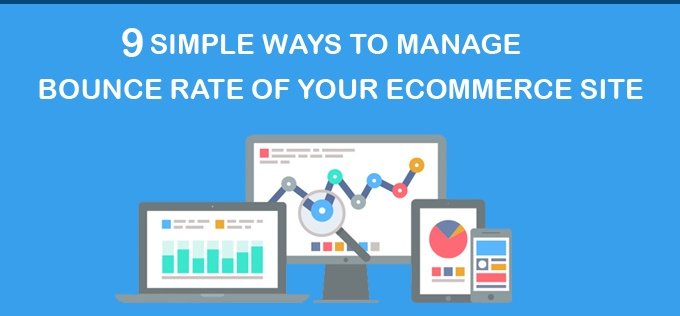9 simple ways to Manage Bounce Rate of your eCommerce site

Majority of people come and leave your website without triggering additional requests in that session because they could not have found any useful pieces of information. So, your conversion rate is low and high bounce rate then your site and content are in need of rebuilding. Make sure that your web site’s bounce rate should be less than the eCommerce’s average bounce rate of 40%.
How to measure Bounce Rate?
Google Analytics assists you to measure your bounce rates on your whole website, landing pages, searched keywords and traffics that come from numerous sources. Even it measures the time spent on your website reading a blog post because it differed between once the guests the primary landed on your page and exit page on your site.
Let’s see following tips which manage Bounce Rate for your eCommerce site:
1. Optimize Page Load Time
Of all the issues an internet page will have, taking forever to load is probably the worst. After all, it doesn’t matter however smart or bad page’s content is that if a user can’t browse it. 40% of people expect a web page load in 2 seconds. You can apply Simple Tricks to Boost your Website page Loading speed and maintenance on your site. You can use tools like Google PageSpeed Insights, Pingdom, and GTmetrix to check your website page load performance. Aside from showing you how fast your website loads, it also provides thorough recommendations on how to improve it.
2. Make Content More Accessible
Use acceptable use of headers, Frequent subheadings, appropriate images and Bulleted lists to makes your content additional accessible and permits the reader to scan or skim your content quickly to spot points that square measure most relevant to their needs.
3. Use Internal Linking Structure
Internal linking is simply linking from one webpage on your website to different. You’re directive your readers to a different resource on your website so that they have one thing to browse later initial page view. It should additionally facilitate to scale back bounce rate on your web site.
4. Open External Links in New Tabs
Linking out to other people or external resources is great for SEO. But it additionally takes your visitors away from your site so set the links to open in an exceedingly new window or tab. This helps cut back our bounce rate and keeps readers eyes on our content longer.
5. Avoid Popup
When you visit a site and a popup disrupts your reading, I think you may decide to leave. Popups will most likely harm your bounce rate. If one in all your major priorities is to decrease your bounce rate, then you'll in all probability wish to remain far away from popups.
6. Offer a Live Chat Help
Performing Live Chat decrease the bounce rate and also increase the conversion rate. Live Chat satisfies the customers more than phone, email, social media and other channels.
7. Make Your Site Easy to Search
If a visitor hits your site and can’t find what they looking for, then they leave a site. So make sure that more easily users can search for and find what they’re looking for, the more likely they are to stick around.
8. Invest in a Responsive Design
Your visitors will be accessing your site either from a laptop, tablet or smartphone. So make sure your site is mobile friendly. Most WordPress themes today are responsive out of the box. But you should always test this yourself. We recommend using Google’s Mobile-Friendly test tool.
9. Navigation should be good
Good navigation wants intuitively checking out how a visitor can be sought for a particular product. Create a sitemap and provide its link in bold on the homepage. Design a clear navigation menu and place it where visitors automatically explore for them.
For an eCommerce site, a high bounce rate is remarkable sign. If you have a careful planning, developing and testing then it will help you to stay visitors back on your site. By reducing bounce rate, a lot of pages of your website are viewed by a lot of guests and multiplied conversions.
Have you seen any other optimizations formula that makes a huge difference? If so, let us know below in the comments. If you need any help to Secure Your WooCommerce Website, stay in touch with us. We are happy to help you.






Comments are closed.